I came here to Co Limerick about 25 years ago to work in environmental education in Kilfinane. That’s what brought me here initially and I still live in Kilfinane now.
I found it really welcoming here and there are good trails in the Ballyhoura Mountains. I was delighted to have all these lovely places to walk on my doorstep, where I feel really safe as well.
I come from a rural area in England, but it isn’t far from London and it wasn’t particularly safe to walk there.
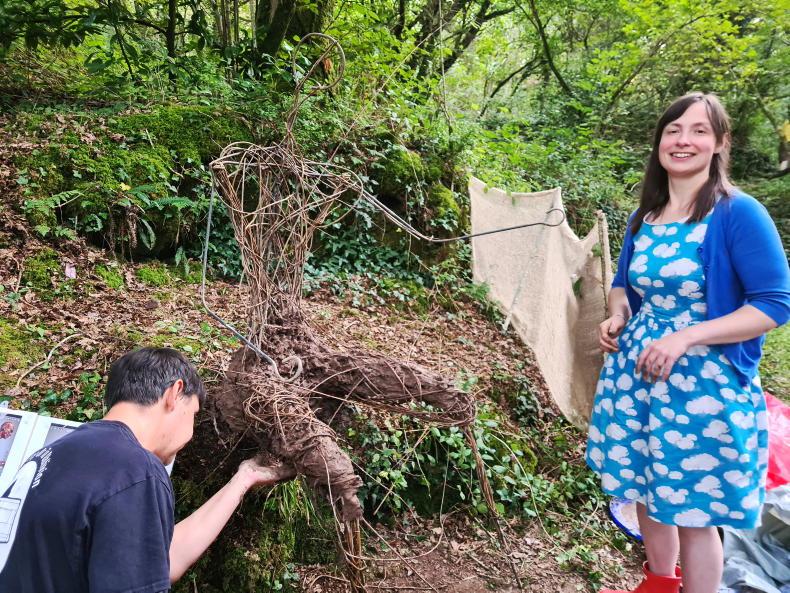
Dave Santorum and Mary McDonald helping to construct Oisín.
I’m an ecologist, first and foremost. I’ve a PhD in the area. Then I’ve always used art to engage people with nature. I use natural materials and I tend to use traditional methods. So for example, I weave, but I use it in a contemporary way.
Mythology and folklore
On this most recent project I worked with two local communities here in east Limerick, Glenroe and Ballyorgan. They’re both small, rural communities.
The project was funded by Limerick Arts Office and the Creative Ireland Programme. I approached the communities about doing some kind of outdoor environmental sculpture. They said they’d like to do something around local legends.
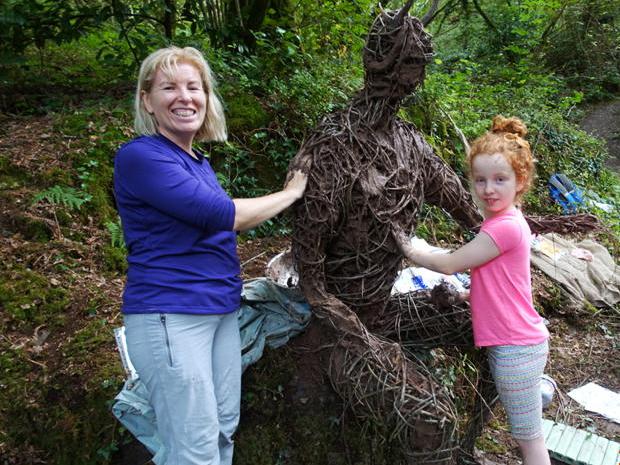
Mags and Niamh Scollard helping to make Oisín.
They picked out some local place names. So there’s Seefin Mountain, which is the seat of Fionn Mac Cumhaill. Just beside that there’s Glenosheen, the glen of Oisín, Fionn Mac Cumhaill’s son. That was our starting point.
Then we set up a little steering group with members from both communities and developed a concept around this. The villages of Glenroe and Ballyorgan are joined by the Keale River Walk. It’s 7km long.
When we had some ideas, we decided to meet in the oak woodland in the middle of the walk. We settled on this idea of Oisín and researched him in Irish folklore. We discussed his character and we came up with an image of this man.
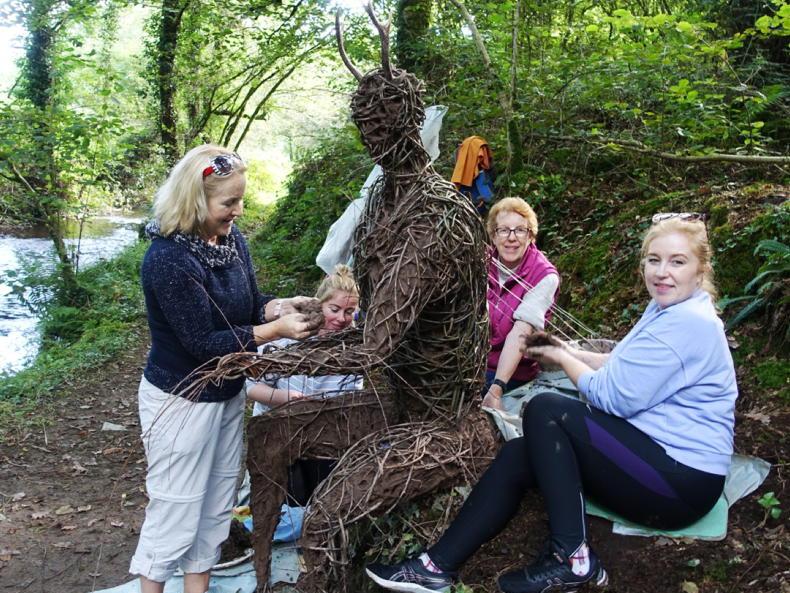
Eileen Cleary, Niamh Walsh, Bríd Hayes and Aoife Hayes working on Oisín.
The sculpture became about Oisín before he goes off to Tír na nÓg. He was already a young man and in Na Fianna. This was Na Fianna’s hunting ground, between here and Knockfierna. He’s taking a quiet moment away from this band of men, to find some inner peace in this beautiful oak woodland and reconnect with his wilder self.
I thought this was really good, because through COVID people have been turning to nature to find solace and we thought this is what Oisín was doing too. We had this concept of this man who was gaining his strength from the oak woodland.
Community inclusivity
We built Oisín in situ in the oak woodland and we used all natural materials. So he’s built out of willow rods and mud from the actual woodland. There’s moss, honeysuckle and ivy running through him. We made him a cloak of leaves too.
The construction method we used for Oisín was wattle and daub. All the houses around here used to be built like that, because there’s very little stone in the area.
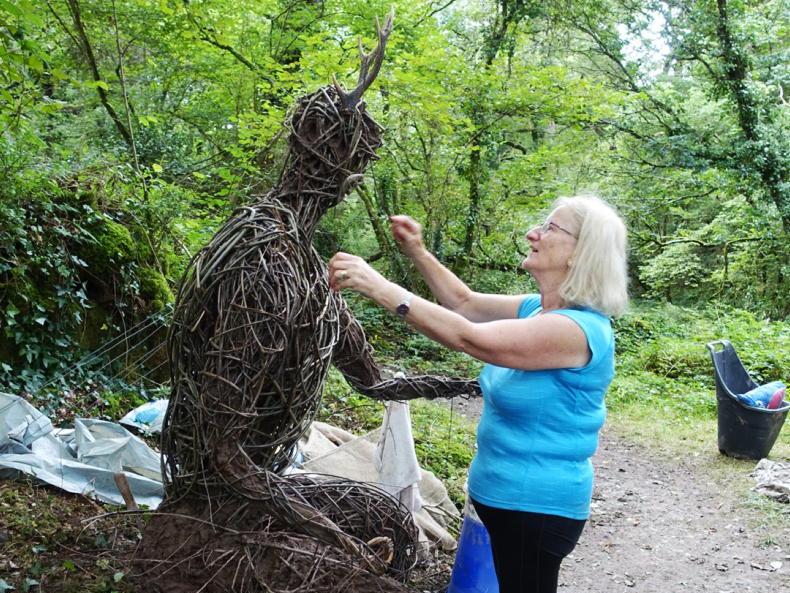
Mary Coffey helping to construct Oisín.
We held workshops for all ages. We had family workshops with little children of three doing leaf prints for the cloak and we had older people making dreadlocks for Oisín. We did some of the work in each of the two villages also, so people who couldn’t walk the 40 minutes into the oak woodland could still participate.
Everybody’s involved in it. I just try to steer it and make sure it’s all working coherently. Obviously with COVID we couldn’t do great, big groups. It’s been very, almost intimate. We would work together for a few hours and then maybe have a picnic together.
Last Sunday, 10 October, we held a community event to celebrate the achievement of finishing the project and to tell the legend of Oisín. We’ve a local bard, Sarah Kelleher, she wove together the traditional stories of Oisín, with our story of making Oisín. In keeping with Oisín being a musician, we collaborated with the local Comhaltas group and had music as well.
Outside the gallery
There’s a counter on this walk and there’s at least 10,000 walkers on it every year. This is a chance for people to see art outside the gallery. It would be a rare exhibition that would have that many people see it, if you think about it. It’s giving people a chance to see art in a different context and to see a different kind of art - this would be in the category of land art.
This is about stepping outside that white box of the gallery. The context of this art is very important. The fact that he’s in this remote oak woodland is important to understanding this work. It wouldn’t even make sense if it was in a gallery.
Also, not everyone goes to galleries, it’s a certain sector of society that goes to galleries. We’re quite distant from galleries in this area, so it’s a chance to encounter art in a more relaxed, accessible way.
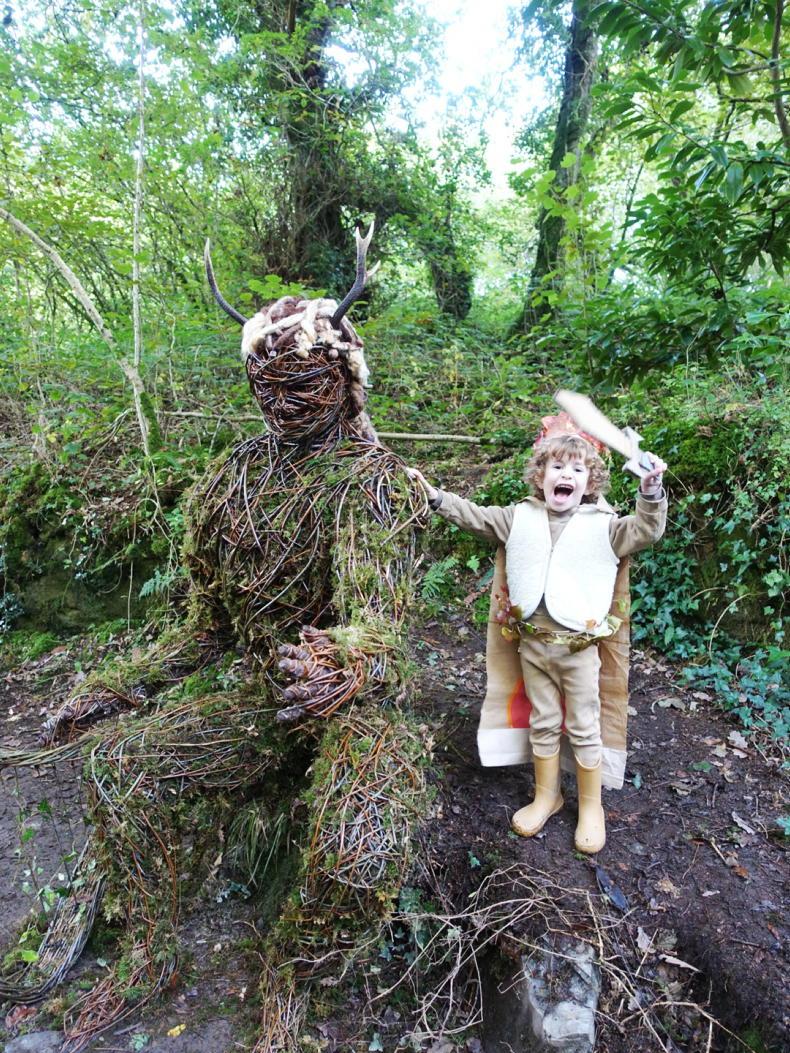
Finn Miguel Coffey de Sa with Oisín.
What’s also been really lovely about this is seeing older people and they’re like children again, playing in nature. You’ve middle aged people making mud pies, it’s how they would have played 30 or 40 years ago.
Most young children now aren’t making mud pies and they’re not jumping in the river to wash off the mud, but this is what they were doing with this.
So it’s like the kids are playing like kids used to and the adults are getting a taste of their childhood again. So everybody leaves in this very Zen, happy mood. CL
Read more
‘A lot of people say the dried flowers remind them of their granny’
From the Big Apple to a Carlow farm
I came here to Co Limerick about 25 years ago to work in environmental education in Kilfinane. That’s what brought me here initially and I still live in Kilfinane now.
I found it really welcoming here and there are good trails in the Ballyhoura Mountains. I was delighted to have all these lovely places to walk on my doorstep, where I feel really safe as well.
I come from a rural area in England, but it isn’t far from London and it wasn’t particularly safe to walk there.

Dave Santorum and Mary McDonald helping to construct Oisín.
I’m an ecologist, first and foremost. I’ve a PhD in the area. Then I’ve always used art to engage people with nature. I use natural materials and I tend to use traditional methods. So for example, I weave, but I use it in a contemporary way.
Mythology and folklore
On this most recent project I worked with two local communities here in east Limerick, Glenroe and Ballyorgan. They’re both small, rural communities.
The project was funded by Limerick Arts Office and the Creative Ireland Programme. I approached the communities about doing some kind of outdoor environmental sculpture. They said they’d like to do something around local legends.

Mags and Niamh Scollard helping to make Oisín.
They picked out some local place names. So there’s Seefin Mountain, which is the seat of Fionn Mac Cumhaill. Just beside that there’s Glenosheen, the glen of Oisín, Fionn Mac Cumhaill’s son. That was our starting point.
Then we set up a little steering group with members from both communities and developed a concept around this. The villages of Glenroe and Ballyorgan are joined by the Keale River Walk. It’s 7km long.
When we had some ideas, we decided to meet in the oak woodland in the middle of the walk. We settled on this idea of Oisín and researched him in Irish folklore. We discussed his character and we came up with an image of this man.

Eileen Cleary, Niamh Walsh, Bríd Hayes and Aoife Hayes working on Oisín.
The sculpture became about Oisín before he goes off to Tír na nÓg. He was already a young man and in Na Fianna. This was Na Fianna’s hunting ground, between here and Knockfierna. He’s taking a quiet moment away from this band of men, to find some inner peace in this beautiful oak woodland and reconnect with his wilder self.
I thought this was really good, because through COVID people have been turning to nature to find solace and we thought this is what Oisín was doing too. We had this concept of this man who was gaining his strength from the oak woodland.
Community inclusivity
We built Oisín in situ in the oak woodland and we used all natural materials. So he’s built out of willow rods and mud from the actual woodland. There’s moss, honeysuckle and ivy running through him. We made him a cloak of leaves too.
The construction method we used for Oisín was wattle and daub. All the houses around here used to be built like that, because there’s very little stone in the area.

Mary Coffey helping to construct Oisín.
We held workshops for all ages. We had family workshops with little children of three doing leaf prints for the cloak and we had older people making dreadlocks for Oisín. We did some of the work in each of the two villages also, so people who couldn’t walk the 40 minutes into the oak woodland could still participate.
Everybody’s involved in it. I just try to steer it and make sure it’s all working coherently. Obviously with COVID we couldn’t do great, big groups. It’s been very, almost intimate. We would work together for a few hours and then maybe have a picnic together.
Last Sunday, 10 October, we held a community event to celebrate the achievement of finishing the project and to tell the legend of Oisín. We’ve a local bard, Sarah Kelleher, she wove together the traditional stories of Oisín, with our story of making Oisín. In keeping with Oisín being a musician, we collaborated with the local Comhaltas group and had music as well.
Outside the gallery
There’s a counter on this walk and there’s at least 10,000 walkers on it every year. This is a chance for people to see art outside the gallery. It would be a rare exhibition that would have that many people see it, if you think about it. It’s giving people a chance to see art in a different context and to see a different kind of art - this would be in the category of land art.
This is about stepping outside that white box of the gallery. The context of this art is very important. The fact that he’s in this remote oak woodland is important to understanding this work. It wouldn’t even make sense if it was in a gallery.
Also, not everyone goes to galleries, it’s a certain sector of society that goes to galleries. We’re quite distant from galleries in this area, so it’s a chance to encounter art in a more relaxed, accessible way.

Finn Miguel Coffey de Sa with Oisín.
What’s also been really lovely about this is seeing older people and they’re like children again, playing in nature. You’ve middle aged people making mud pies, it’s how they would have played 30 or 40 years ago.
Most young children now aren’t making mud pies and they’re not jumping in the river to wash off the mud, but this is what they were doing with this.
So it’s like the kids are playing like kids used to and the adults are getting a taste of their childhood again. So everybody leaves in this very Zen, happy mood. CL
Read more
‘A lot of people say the dried flowers remind them of their granny’
From the Big Apple to a Carlow farm






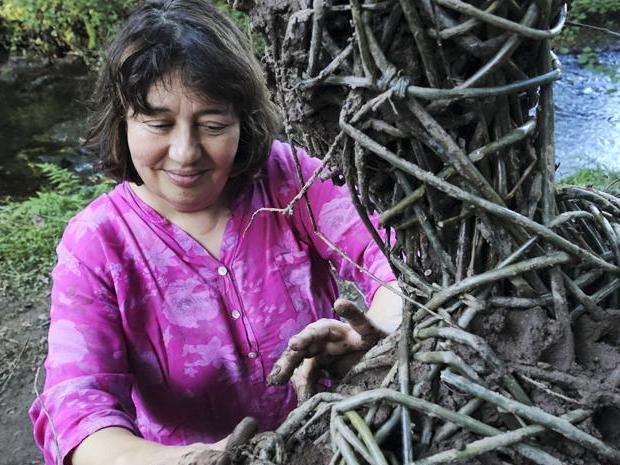




 This is a subscriber-only article
This is a subscriber-only article










SHARING OPTIONS: